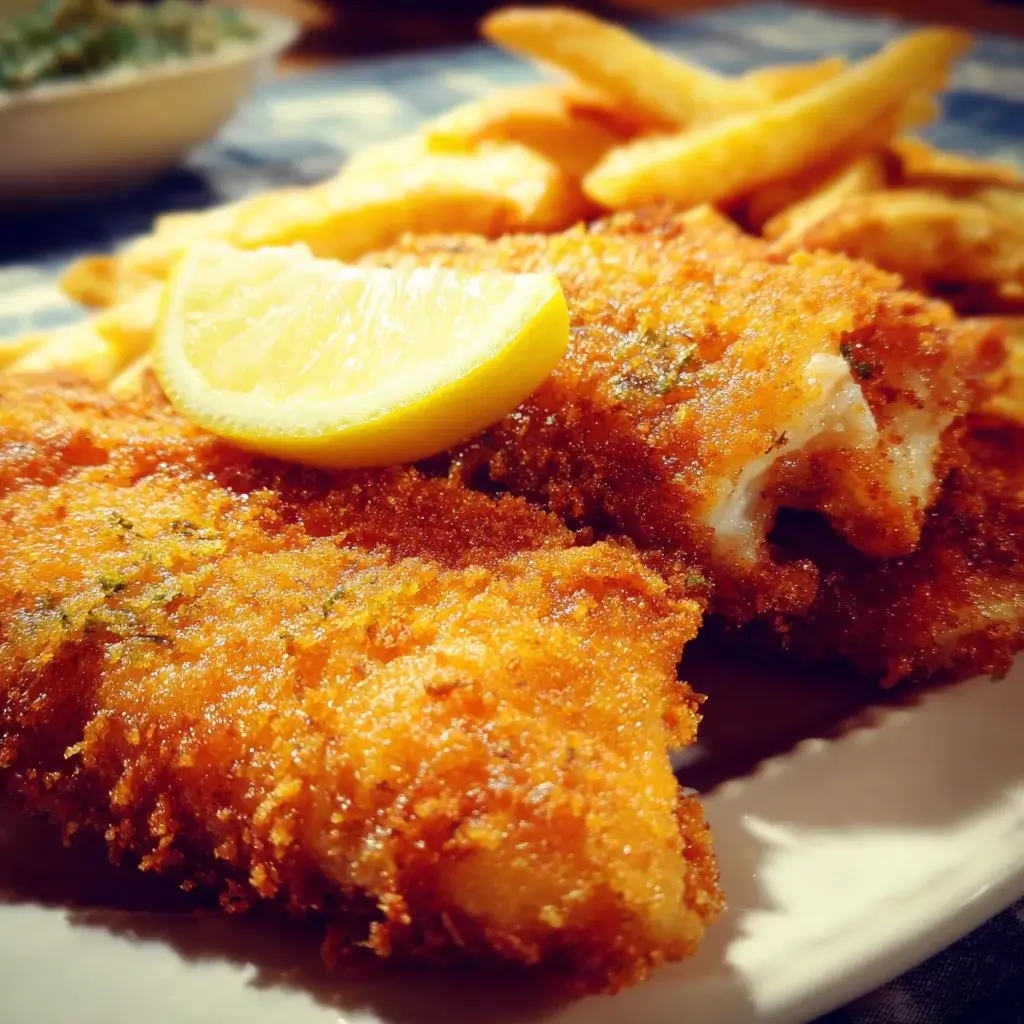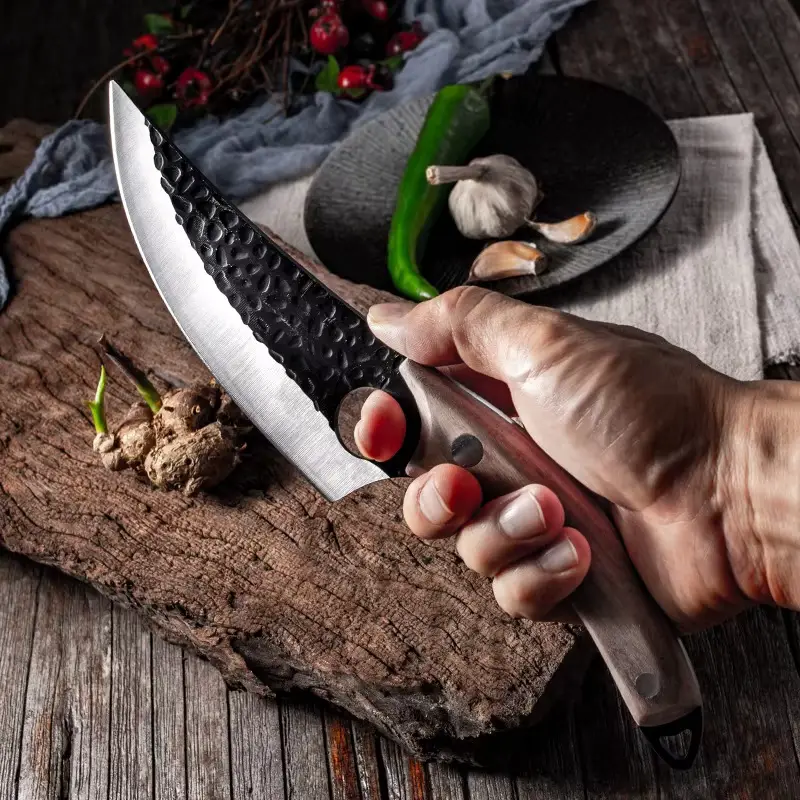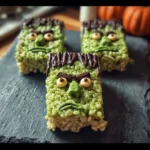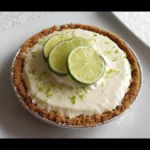There is a sound that, to me, is the epitome of comfort food: the violent, energetic sizzle of battered fish hitting hot oil. It’s a sound that promises a shatteringly crisp, golden-brown crust giving way to perfectly steamed, flaky white fish within. For years, my quest for the perfect homemade deep-fried fish was a journey of trial and error. I battled soggy batters, greasy coatings, and fish that was either undercooked or overcooked. Then came the breakthrough. After tinkering with ratios, temperatures, and techniques, I finally landed on this recipe. The first time I served it for our family’s Friday “fish and chips” night, the room went silent, save for the sound of enthusiastic crunching. My son, a notoriously tough food critic, looked up from his plate with wide eyes and said, “Dad, this is better than the restaurant.” That was it. That was the moment I knew I had cracked the code. This isn’t just a recipe; it’s a victory lap, a guaranteed crowd-pleaser that will make you the undisputed champion of your kitchen.
Why This is the Ultimate Deep-Fried Fish Recipe
In a sea of recipes for fried fish, what makes this one the definitive guide to golden, crispy perfection? It boils down to a deep understanding of the science behind a great fry. This recipe is engineered for success, focusing on three critical elements: the batter, the fish, and the technique.
First, let’s talk about the batter. This isn’t your average, heavy, doughy coating. This is a light, airy, and incredibly crispy beer batter that creates a protective shell around the fish. The secret lies in a trifecta of ingredients. We use a combination of all-purpose flour for structure and cornstarch, which is a pure starch that fries up exceptionally crispy and light. The leavening comes from two sources: baking powder provides a chemical lift, but the real star is the ice-cold beer. The carbonation in the beer creates thousands of tiny bubbles that expand in the hot oil, resulting in a batter with a delicate, lacy, and shatteringly crisp texture. The batter is also perfectly seasoned, ensuring that every single layer of your dish is packed with flavor, not just the fish inside.
Second is the focus on the fish itself. The recipe ensures that the star of the show, the delicate white fish, is cooked to flaky, moist perfection. The super-effective batter acts as an insulator, creating a steamy environment that gently cooks the fish from the inside out. This prevents the fish from becoming dry or tough, which can happen with less effective batters or improper cooking temperatures. By the time the exterior is a deep golden brown, the interior is perfectly steamed, so tender it flakes apart with the gentle nudge of a fork.
Finally, the technique is foolproof. We cover the crucial steps that professionals use but are often omitted in home recipes. We’ll discuss the importance of patting the fish completely dry, the necessity of a light flour dredge before battering (the secret to making the batter stick!), the critical role of oil temperature, and the cardinal rule of not overcrowding the pan. By following these steps, you eliminate the guesswork and all the common pitfalls that lead to greasy, soggy, or unevenly cooked fish. You’re not just following steps; you’re learning the craft of deep-frying, empowering you to make flawless fried fish every single time.
The Key Components for Crispy, Golden Fish
The magic of this recipe lies in its simplicity and the quality of its components. Each ingredient has a specific job to do, and understanding its role will help you achieve a perfect result.
The Fish: The Flaky Star of the Show
The type of fish you choose is paramount. You want a firm, mild, white fish that flakes easily when cooked. Avoid oily or strongly flavored fish like salmon or mackerel. The top contenders are:
- Cod: The quintessential choice for classic fish and chips. It has large, tender flakes and a mild, slightly sweet flavor that is the perfect canvas for the crispy batter.
- Haddock: Very similar to cod, haddock is slightly sweeter and has a finer flake. It’s another excellent, classic choice.
- Pollock: A more budget-friendly option from the same family as cod. It has a slightly stronger flavor but a firm texture that holds up beautifully to frying.
- Halibut: A premium choice. Halibut is very firm, meaty, and has a clean, mild flavor. Its firm texture makes it very easy to handle.
The Batter: The Secret to the Crunch
- All-Purpose Flour: This provides the main structure for our batter.
- Cornstarch: The secret weapon for extra crispiness. Cornstarch fries up lighter and crispier than flour alone and helps create a delicate crust.
- Baking Powder: A chemical leavening agent that works with the beer to create an airy, light texture.
- Seasonings (Salt, Black Pepper, Paprika, Garlic Powder): We season the batter itself to ensure flavor in every bite. The paprika also adds a beautiful golden color to the finished product.
- Ice-Cold Beer: This is for flavor and leavening. A light-flavored lager or pilsner is perfect. The carbonation creates a light, bubbly texture. It must be ice-cold to slow down gluten development, keeping the batter tender, not tough.
- Egg: An egg yolk adds richness, color, and helps bind the batter together.
The Frying Medium: The Oil
- High Smoke Point Oil: This is non-negotiable. You need an oil that can handle the high heat of deep-frying (350-375°F or 175-190°C) without burning and smoking. Excellent choices include peanut oil (great flavor), canola oil, vegetable oil, or grapeseed oil. Do not use olive oil.
The Ultimate Deep-Fried Fish: Complete Ingredient List
For the Fish:
- 2 lbs (900g) Firm White Fish Fillets (like cod, haddock, or pollock), cut into 4-5 inch pieces
- ½ cup (60g) All-Purpose Flour (for dredging)
- Salt and Freshly Cracked Black Pepper
For the Beer Batter:
- 1 ¼ cups (150g) All-Purpose Flour
- ¼ cup (30g) Cornstarch
- 2 teaspoons Baking Powder
- 1 teaspoon Salt
- ½ teaspoon Black Pepper
- ½ teaspoon Paprika
- ½ teaspoon Garlic Powder
- 1 large Egg Yolk
- 12 oz (355ml) very cold, light-flavored Beer (like a lager or pilsner)
For Frying:
- 48-64 oz (1.5-2 quarts or 1.5-2 Liters) Neutral, High-Smoke-Point Oil (like peanut, canola, or vegetable oil)
Step-by-Step Instructions for Flawless Fried Fish
Follow these detailed steps carefully for a perfect result. The key is to have everything prepared and work efficiently once the oil is hot.
Step 1: Prepare the Fish and Dredging Station
Thoroughly pat your fish fillets completely dry with paper towels. This is a critical step; a dry surface helps the batter adhere properly. Season the fish pieces generously on all sides with salt and pepper. Set up a shallow dish or plate with the ½ cup of flour for dredging.
Step 2: Heat the Oil
Pour the oil into a large, heavy-bottomed pot, Dutch oven, or deep skillet. You want the oil to be at least 2-3 inches deep. Attach a deep-fry or candy thermometer to the side of the pot. Heat the oil over medium-high heat until it reaches a steady temperature of 375°F (190°C). Maintaining the correct oil temperature is the most important key to crispy, not greasy, fish.
Step 3: Prepare Your Landing Zone
While the oil is heating, set up a wire cooling rack over a baking sheet. This is where you will place the fish immediately after frying. Placing it on a wire rack allows air to circulate, keeping the bottom of the fish just as crispy as the top. Do not place fried fish on paper towels, as this will trap steam and make the crust soggy.
Step 4: Make the Batter (At the Last Minute)
Do not make the batter ahead of time. You want to make it right before you are ready to fry to keep the beer’s carbonation as active as possible. In a large mixing bowl, whisk together the 1 ¼ cups of flour, cornstarch, baking powder, salt, pepper, paprika, and garlic powder. In a small bowl, lightly beat the egg yolk. Create a well in the center of the dry ingredients and add the egg yolk. While whisking continuously, slowly pour in the ice-cold beer. Whisk just until the batter is combined. A few small lumps are perfectly fine—do not overmix, as this will develop gluten and make the batter tough.
Step 5: Dredge and Batter the Fish
Working with one piece of fish at a time, dredge it in the plain flour, ensuring it is lightly coated on all sides. Shake off any excess flour. This dry layer acts like a primer, giving the wet batter something to cling to. Immediately dip the floured fish into the beer batter, turning to coat it completely. Let any excess batter drip off for a second or two.
Step 6: Fry the Fish to Golden Perfection
Carefully lower the battered piece of fish into the hot oil. Do not overcrowd the pot. Fry only 2-3 pieces at a time, depending on the size of your pot. Overcrowding will cause the oil temperature to drop dramatically, resulting in greasy, soggy fish. Fry for about 4-6 minutes, turning the pieces halfway through, until the batter is a deep golden brown, beautifully puffed, and crisp.
Step 7: Drain and Season
Using a spider strainer or slotted spoon, remove the fish from the oil and transfer it directly to the prepared wire rack. Immediately sprinkle the hot fish with a little more salt. The salt will adhere perfectly to the hot, freshly fried surface. Allow the oil to return to 375°F (190°C) before frying the next batch.
Nutritional Information (An Estimation)
Please note that this is an approximation. The final nutritional value will depend on the type of fish, the type of oil, and how much oil is absorbed during frying.
- Servings: 4-6
- Serving Size: 1-2 pieces of fish (approx. 6-8 oz)
- Calories per serving: Approximately 500-650 kcal
Time Commitment: Prep and Cook Time
- Preparation Time: 15 minutes
- Cook Time: 20-25 minutes (in batches)
- Total Time: Approximately 35-40 minutes
How to Serve Your Perfect Deep-Fried Fish
The classic presentation is just the beginning. This perfectly fried fish is a versatile base for many delicious meals.
- The Quintessential Fish and Chips:
- Serve piping hot alongside thick-cut French fries (known as “chips”).
- Provide small bowls of classic condiments: tangy tartar sauce, a lemon wedge for squeezing, and a bottle of malt vinegar for a sharp, acidic kick.
- A side of creamy coleslaw or traditional mushy peas completes the authentic pub experience.
- Legendary Fish Tacos:
- Break the fried fish into large chunks.
- Serve in warm corn or flour tortillas.
- Top with a crunchy slaw (like a red cabbage and jalapeño slaw).
- Drizzle with a creamy sauce like a chipotle crema or a cilantro-lime sour cream.
- Finish with a squeeze of fresh lime, crumbled cotija cheese, and fresh cilantro.
- The Ultimate Fish Sandwich:
- Place a whole fried fillet on a soft, toasted brioche bun.
- Spread the bun generously with tartar sauce.
- Top with crisp iceberg lettuce and a slice of sharp cheddar cheese for a “fish-fillet” style sandwich.
- A Lighter (But Still Indulgent) Meal:
- Serve a piece of fried fish on top of a large, fresh green salad with a simple lemon vinaigrette. The contrast of the hot, crispy fish and the cool, crisp salad is delightful.
Mastering the Deep Fry: 5 Additional Tips for Perfection
- Oil Temperature is Everything: This cannot be overstated. A deep-fry thermometer is not a suggestion; it is an essential tool for this recipe. If the oil is too cool (below 350°F), the batter will absorb too much oil and become greasy. If it’s too hot (above 400°F), the batter will burn before the fish inside has a chance to cook through. Keep it locked in at 375°F.
- The Double Fry for Ultimate Crispness: For a truly professional, shatteringly crisp crust that stays crunchy for even longer, try the double-fry method. Fry the fish for 3-4 minutes at a lower temperature, around 325°F (160°C), until it’s lightly colored but cooked through. Remove and let it rest on the wire rack. Then, increase the oil temperature to 375-400°F (190-200°C) and fry the fish again for just 1-2 minutes until it’s a deep golden brown.
- The Secret is Dryness: Patting the fish dry with paper towels is a step many people skip, but it’s vital. Moisture is the enemy of adhesion. A damp fish fillet will create a layer of steam between the fish and the batter, causing the beautiful crust to slide right off.
- Keep Your Batter Ice-Cold: A cold batter is a happy batter. The cold temperature slows gluten formation, keeping the crust tender. It also creates a greater temperature shock when it hits the hot oil, which helps make it extra crispy. You can even place your bowl of batter inside a larger bowl of ice water to keep it chilled while you work.
- Hold in a Warm Oven: If you are cooking for a crowd and need to fry in several batches, you can keep the finished fish warm and crispy. Preheat your oven to a low temperature, around 200°F (95°C). Place the wire rack with the fried fish on the baking sheet and put it in the warm oven. This will keep everything hot and crisp until you are ready to serve.
Frequently Asked Questions About Deep-Fried Fish
1. Why was my batter soggy and greasy?
This is the most common issue and is almost always caused by incorrect oil temperature. If the oil is not hot enough, the batter soaks up oil instead of instantly crisping. The other common culprit is overcrowding the pot, which causes a drastic drop in temperature. Use a thermometer and fry in small batches.
2. Can I make this recipe without beer? What’s a good substitute?
Yes, you can. The primary function of the beer is its carbonation. You can substitute the beer with an equal amount of very cold seltzer water or club soda. You will lose the subtle malty flavor from the beer, but you will still get an incredibly light and crispy batter from the bubbles.
3. Why did the batter fall off my fish?
This usually happens for two reasons. First, the fish was too wet when you started. You must pat it thoroughly dry. Second, you skipped the initial dredging step in plain flour. That light flour coating acts as a primer that the wet batter can grab onto. Without it, the wet batter has a hard time adhering to the smooth, slick surface of the fish.
4. Can I bake or air-fry this batter?
Unfortunately, no. This is a wet batter specifically designed for the environment of a deep fryer. In an oven or air fryer, a wet batter will simply drip off the fish, creating a huge mess and a disappointing result. For baking or air frying, you need a different style of coating, typically a three-step breading process (flour, egg, then dry breadcrumbs like panko).
5. How do I store and reheat leftover fried fish?
Fried fish is always best eaten immediately. However, if you have leftovers, store them in an airtight container in the refrigerator for up to 2 days. To reheat and bring back some of the crispness, do not use a microwave, as it will make the crust steamy and rubbery. The best method is to use an oven or an air fryer. Preheat to 375°F (190°C) and heat the fish for 5-8 minutes, or until it is hot and the crust has crisped up again. It won’t be quite as perfect as fresh, but it will be surprisingly close.
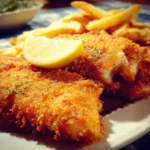
Deep-Fried Fish recipe
Ingredients
For the Fish:
-
2 lbs (900g) Firm White Fish Fillets (like cod, haddock, or pollock), cut into 4-5 inch pieces
-
½ cup (60g) All-Purpose Flour (for dredging)
-
Salt and Freshly Cracked Black Pepper
For the Beer Batter:
-
1 ¼ cups (150g) All-Purpose Flour
-
¼ cup (30g) Cornstarch
-
2 teaspoons Baking Powder
-
1 teaspoon Salt
-
½ teaspoon Black Pepper
-
½ teaspoon Paprika
-
½ teaspoon Garlic Powder
-
1 large Egg Yolk
-
12 oz (355ml) very cold, light-flavored Beer (like a lager or pilsner)
For Frying:
-
48-64 oz (1.5-2 quarts or 1.5-2 Liters) Neutral, High-Smoke-Point Oil (like peanut, canola, or vegetable oil)
Instructions
Step 1: Prepare the Fish and Dredging Station
Thoroughly pat your fish fillets completely dry with paper towels. This is a critical step; a dry surface helps the batter adhere properly. Season the fish pieces generously on all sides with salt and pepper. Set up a shallow dish or plate with the ½ cup of flour for dredging.
Step 2: Heat the Oil
Pour the oil into a large, heavy-bottomed pot, Dutch oven, or deep skillet. You want the oil to be at least 2-3 inches deep. Attach a deep-fry or candy thermometer to the side of the pot. Heat the oil over medium-high heat until it reaches a steady temperature of 375°F (190°C). Maintaining the correct oil temperature is the most important key to crispy, not greasy, fish.
Step 3: Prepare Your Landing Zone
While the oil is heating, set up a wire cooling rack over a baking sheet. This is where you will place the fish immediately after frying. Placing it on a wire rack allows air to circulate, keeping the bottom of the fish just as crispy as the top. Do not place fried fish on paper towels, as this will trap steam and make the crust soggy.
Step 4: Make the Batter (At the Last Minute)
Do not make the batter ahead of time. You want to make it right before you are ready to fry to keep the beer’s carbonation as active as possible. In a large mixing bowl, whisk together the 1 ¼ cups of flour, cornstarch, baking powder, salt, pepper, paprika, and garlic powder. In a small bowl, lightly beat the egg yolk. Create a well in the center of the dry ingredients and add the egg yolk. While whisking continuously, slowly pour in the ice-cold beer. Whisk just until the batter is combined. A few small lumps are perfectly fine—do not overmix, as this will develop gluten and make the batter tough.
Step 5: Dredge and Batter the Fish
Working with one piece of fish at a time, dredge it in the plain flour, ensuring it is lightly coated on all sides. Shake off any excess flour. This dry layer acts like a primer, giving the wet batter something to cling to. Immediately dip the floured fish into the beer batter, turning to coat it completely. Let any excess batter drip off for a second or two.
Step 6: Fry the Fish to Golden Perfection
Carefully lower the battered piece of fish into the hot oil. Do not overcrowd the pot. Fry only 2-3 pieces at a time, depending on the size of your pot. Overcrowding will cause the oil temperature to drop dramatically, resulting in greasy, soggy fish. Fry for about 4-6 minutes, turning the pieces halfway through, until the batter is a deep golden brown, beautifully puffed, and crisp.
Step 7: Drain and Season
Using a spider strainer or slotted spoon, remove the fish from the oil and transfer it directly to the prepared wire rack. Immediately sprinkle the hot fish with a little more salt. The salt will adhere perfectly to the hot, freshly fried surface. Allow the oil to return to 375°F (190°C) before frying the next batch.
Nutrition
- Serving Size: one normal portion
- Calories: 500-650 kcal


